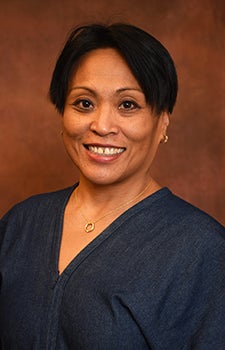
Human trafficking remains a critical global problem
Despite toiling up to 18 hours a day, Rhoda, a Filipina migrant domestic worker in the United Arab Emirates (UAE), was given food only once every 24 hours by her employers, who insisted she must finish all her daily chores before eating.
“They expected her to survive just drinking water throughout the day,” said Rhacel Parrenas, professor of sociology and gender studies at USC Dornsife College of Letters, Arts and Sciences and an expert on human trafficking.
Parrenas is the author of Illicit Flirtations: Labor, Migration, and Sex Trafficking in Tokyo (Stanford University Press, 2011), which explores the working conditions of what in the mid-2000s was the largest group of human trafficking victims — Filipino migrant hostesses in Japan.
She interviewed Rhoda — whose last name is omitted to protect her identity —for her current research on Southeast Asian migrant domestic workers in the UAE. It is one of 165 in-depth interviews Parrenas has completed on workers’ experience of what she prefers to term “unfree labor,” but which is often described by those within the trafficking community as modern-day slavery.
Trafficking, Parrenas explains, differs very little whether it occurs in the United States or in the Middle East. “In the U.S., it’s very hard to quantify the extent of trafficking because it’s a hidden problem,” she said. “A lot of trafficked people don’t speak out, so we never really know about them.”

Rhacel Parrenas. Photo courtesy of Rhacel Parrenas.
However, Parrenas notes, the National Human Trafficking Hotline, which is run by Polaris, reports that in 2017 it received calls from around 10,000 people.
California Superior Court Judge Curtis Kin agrees that in the U.S. we tend to underestimate the scale of human trafficking, believing it occurs in other countries rather than right here on our doorstep.
“It’s the type of crime that can go unnoticed due to its hidden nature, so raising awareness among the community so that it can be discovered and reported is the best way to combat trafficking,” he said.
Kin, who earned his bachelor’s in international relations from USC Dornsife in 1993, first got involved in fighting human trafficking as a federal prosecutor working for the U.S. Department of Justice in Los Angeles. As head of the unit specializing in sex and labor trafficking, he supervised cases and trained prosecutors to work with federal agents to bring traffickers to justice.
A victim-centered approach
In 2008, Kin successfully prosecuted what at the time was the largest international human sex trafficking case ever brought by the U.S. Department of Justice. It involved Guatemalan minors and young women forced into prostitution in the U.S.
Heightened awareness helps people understand that many who once were prosecuted for prostitution might actually be the victims, with the real crime being trafficking, Kin said. “This victim-centered approach needs to be shared not only in the law enforcement community but also in the community at large.”
To that end, Kin has also trained government officials, law enforcement officers and victim rights advocates in Jordan, Saudi Arabia, Moldova, Egypt and throughout the U.S.
While acknowledging the extreme seriousness of sex trafficking, Parrenas argues that it represents a smaller problem than the widespread labor trafficking faced by many temporary migrant workers whose legal resident status is conditional upon their working solely for one employer. This, she notes, makes them very vulnerable to abuse. In many cases, she found, migrant workers only discover upon arrival that they will be paid far less than originally promised — often less than half.
“That psychological toll of thinking you’re going to get something and then you arrive and discover you’re going to receive half of what you thought, and the work is more challenging than you ever imagined it to be, and yet you can’t quit your job because you need your employer’s permission, is huge,” Parrenas said.
Modern-day slavery
Kin says that while it’s important to note that trafficking doesn’t usually resemble slavery in the traditional sense, where people are chained or beaten — although that can still occur — at its root, modern day traffickers are still compelling or coercing somebody to do something against their will, either in terms of labor or commercial sex.

Curtis Kin. Photo by Damon Casarez.
This, Kin points out, can be done in subtle, hidden ways involving sophisticated psychological or economic coercion and nonviolent threats, potentially to the victim’s family.
For example, Joy, another Filipina worker interviewed by Parrenas, was not given a single day off by her employers, a Yemeni family, during the five years she worked for them. The family also refused to allow her to quit her job and held her salary, on the pretext that they did not want her to “squander” it. Joy only learned her rights after visiting a UAE government office. Armed with an official letter, she finally persuaded her employers to let her go.
Her troubles were not over, however. Her next job, with a Saudi household, lasted 14 years, during which she still didn’t receive a day off.
Parrenas stresses that while Rhoda and Joy’s cases are shocking, they’re certainly not the worst she has uncovered. Many migrant workers face even more appalling abuses, including being beaten or starved.
“In those cases, especially if they don’t have a day off — which is also normal —, it’s very hard for these women to escape. Also, they can’t leave their job unless they have the permission to quit of the employer who’s hitting them,” she said.
Parrenas thinks anti-immigrant sentiment in the U.S. is to blame for the failure to take the legal steps necessary to protect migrant workers and prevent human trafficking.
“It’s important that we use International Human Trafficking Awareness Day to call attention to how receiving countries put migrants in a legal position of vulnerability,” she said. “That should be front and center of our discussion of immigration today.”